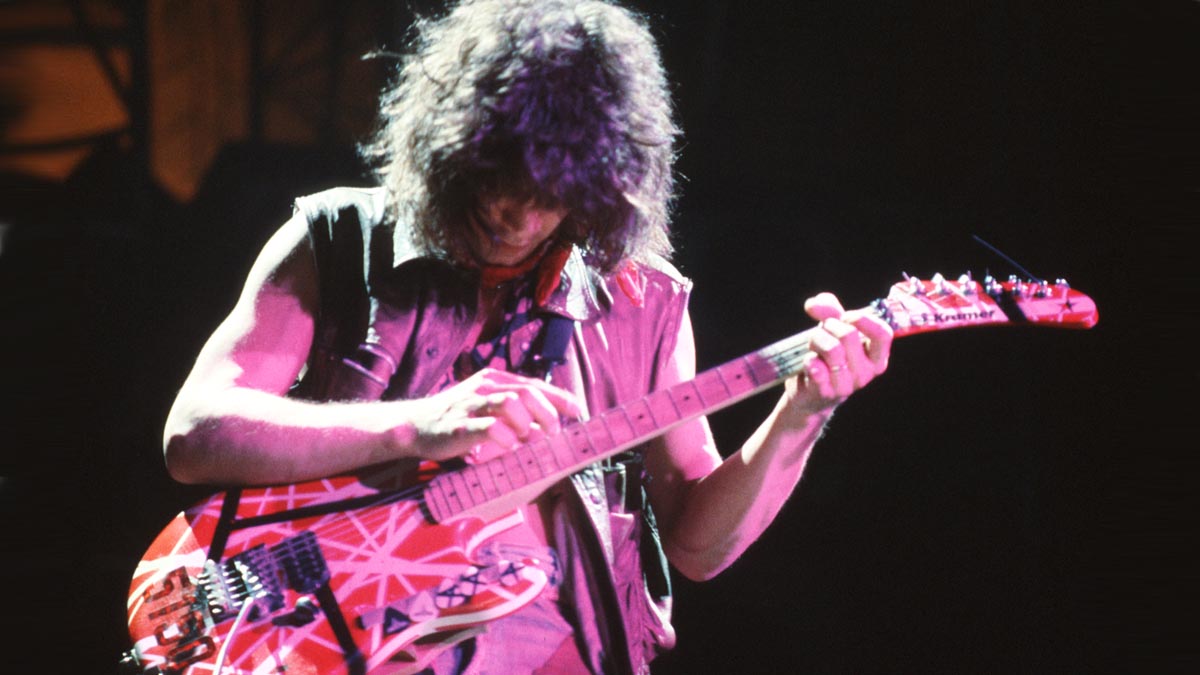Yvette Young names the 10(+) guitarists who shaped her sound
Covet’s two-hand tapping math-rock mastermind reveals why she only just started listening to Van Halen, what it’s like to jam with Steve Vai and the guitar discovery that changed her life

Yvette Young may be one of today’s most inspiring players, but she admits she’s a little late to the game when it comes to quote-unquote classic guitar music.
“It’s all new!” she laughs. “I just started listening to Metallica a little bit. I recently listened to bands like Van Halen more. I slept on that for too long. It’s just because in my upbringing I was only allowed to listen to classical music. So I’m super-late with everything.”
Since breaking free of her classical wunderkind origin story, Young has transitioned into a next-generation electric guitar hero, with an Ibanez signature guitar to her name and an expansive new album, Catharsis, from her band Covet ready to drop. But none of that would have happened if she hadn’t embarked upon a fateful journey that changed the course of her musical flight path.
“I was on a plane and I discovered punk music,” she recalls. “I think the first band I listened to in that genre was like The Living End, and I thought it was really catchy. Then I saw a video for The Darkness – I Believe in a Thing Called Love. And I was like, ‘This is wild. I’ve never seen anything like this. This rules.’”
From there, Young was off to the races – with grunge-metallers Chevelle a surprise early favorite – but it wasn’t until she discovered Midwest emo and its trademark alternate tunings that she found her home (more on that later).
With a background spread across the musical map, Young now seeks to merge seemingly disparate guitar worlds: the old guard, the new wave and everything in between.
“I have impostor syndrome all the time,” she laughs. “I’m an outsider – I taught myself. I didn’t even hear rock ’n’ roll until I heard The Darkness, which is crazy.
Get The Pick Newsletter
All the latest guitar news, interviews, lessons, reviews, deals and more, direct to your inbox!
“I feel like I’m in a really privileged position in that I’m also bridging two worlds. I can see it at my shows. We got the indie kids who love bands like Porches or something from that world. And then we got the virtuosic shred guitar dads that I got to teach at Vai Academy. And they’re all in a room.
“It’s all about unifying, right? Because everyone there is guided by the common love for music in general. But it’s all kinds of demographics, all ages, shapes, sizes, genders, orientations… everything!”
As she gears up to name the 10 – and a fair few more – players who shaped her sound, the Ibanez signature artist notes there are some common threads that bind her wide-ranging picks.
“I would say I’m less attracted to crazy virtuosity and more, like, emotion,” Young explains. “Some of my favorite guitar solos ever are a couple of jangly notes that just hit really special. And I’m after whatever that magical feeling is.”
And with that, in roughly chronological order, here are the guitarists that made Yvette Young the trailblazing player she is today – starting with a moment that changed her life forever…
1. Yamazaki Hirokazu/Mino Takaaki (Toe) and Mike Kinsella/Steve Holmes (American Football)
“Honestly, the most life-changing thing I ever did was tune my guitar to FACGBE, which I attribute to Toe and American Football. Because I used to just write chord stuff that sounded like standard cowboy chords. And then I changed up my tuning and I was like, ‘This is the sound I love. I’m using my ear now. I’m hearing stuff instead of just playing the chords and the shapes you’re supposed to play.’
“And I just started writing – I wrote a song a week. It was so quick – sometimes two songs a week, just from that tuning, because I was so inspired. Thank you, Mike Kinsella, thank you, Toe.
“As someone who comes from a classical background, the reason why post-rock was so alluring to me was because it reminded me of classical music in that it’s very dynamic; it goes for a long time. And it has movements – it develops, like variations on one theme. So you’ve got the upbeat intro and then you’ve got the calm middle, and then it climaxes into this big epic thing and then sometimes it can end on that or it can end in a soft outro.
“That format was really intuitive and made sense to me, just from my classical days of playing Romantic-era stuff that also flowed and was dynamic like that. I really, really love [American Football song] Stay Home just because it has one theme; it’s looped and then it’s just building layers upon layers upon layers. I think it was such clever polyphony and phrasing. That’s what got me into looping.”
2. Tim Collis (TTNG)
“Tim Collis was a big influence growing up. He definitely did a lot of tapping – and I don’t do nearly as creative double-capo stuff, but I think that is really impressive. And I love his ear for harmony.
“TTNG’s music is so cool, and I think sonically that really inspired me as well. I really love 26 Is Dancier Than 4 – I remember I listened to that song, like, two-million times. I’m probably all their Spotify plays! But I really love that song. The tapping sound was so cool to me. And that’s kind of why I wanted to try that. So I had to write stuff that sounds in that vein.”
3. Guthrie Govan

“One day I randomly discovered Guthrie Govan. I was like, ‘Wow, guitar can sound like singing.’ It’s very melodic with very cool phrasing. I learned Waves a long time ago – I thought I should learn something in standard tuning. So I learned the beginning of Waves. And I was like, ’The rest of this is wild. I’m out!’ [laughs]
“That record, Erotic Cakes, is so versatile, too. He has a wide range. He’s doing these like flowy, epic, lyrical [runs] – it’s more like melodic shred. And then, the chicken pickin’ one [Rhode Island Shred] is country stuff. And then Fives, it’s just a very good melody. I was attracted to that.”
4. Evan Stephens Hall (Pinegrove)

“I adore the tones that Evan gets. I got recommended their stuff because of American Football. And I think the first song I heard was Aphasia – that has a really, really sick guitar solo. That’s one of my favorite solos.
“My rule is if something makes me stop what I’m doing and just listen, it’s really special. And I should add it to my playlists to check out later. So that song did that to me. I was like, ‘Oof, that solo at the end sounds like a person pleading to you or something.’ I love that – the lyrical, vocal quality of guitar. So yeah, every album since I’ve been like, ‘Banger. Banger. Banger’. So good.”
5. Joe Reinhart (Algernon Cadwallader)
“I told you earlier, I was on the plane, I discovered The Living End – I was like, ‘This is cool. They have cool hair and weird ties.’ And then from that, I jumped into the Midwest emo world and that’s when Algernon Cadwallader hit. I bought the record Parrot Flies, and it’s got riffs and riffs and riffs. So I love that guitarist [Joe Reinhart].
“It’s so high-energy and it’s got that jangly kind of Midwest emo tone. I always wish that I had a – I don’t know how to say this without sounding derogatory – but sometimes their vocals sound like a prepubescent boy trying to sing with their voice cracking and stuff. Like, I wanted to do that – I thought it was so cool to do gang vocals and sing out of tune.
“And I know a lot of people would find this, like, abhorrent and terrible, but I think that’s what attracted it to me, because it’s not this polished crystal thing that’s like, ‘cherish’. It’s like, okay, yeah, everyone’s making mistakes. Everyone’s singing out of key, but it’s about the energy and it’s just so good. Again, it’s about emotion – it captured something really special and it really resonated with me.”
6. Eoin Whitfield/Lewis Jackson (Enemies)
“I’m obsessed with them. I feel like I’m really inspired by them, just for the cool melodies, guitars weaving in and out of each other, the really interesting rhythmic things happening. I grew up on that British and Irish math-rock scene – like the British math-rock scene and the Midwest emo scene in America got married.
“By this time, I was listening to super-esoteric math shred like Hella, No Age, Tera Melos – all of that. I was really into that noise thing for a while. But then at this point, I’m just like, ‘Well, I really like catchy melodies, and I think it’s cool.’ The way I think about it now is that the more you do have accessibility the wider the demographic you expose to this niche genre, which is really exciting, because you’re getting people used to listening to odd-meter things and more progressive elements.
“So I think Enemies does a really great job in bridging that accessibility thing with the whole progressive thing. I never got to see them live, but I hope one day if they reunite, I will fly there.” [Editor’s note: since our conversation took place, Enemies announced a reunion show after seven years of inactivity – better book those plane tickets…]
7. Jon Gomm, Erik Mongrain, Kaki King
“This one’s a bunch of different players that I listened to growing up and I really love – that’s how I got into fingerstyle. Erik Mongrain, Jon Gomm, Kaki King – the whole fingerstyle guitar genre. Also, I gotta give props to bands that have any of that acoustic fingerstyle stuff. Like Owen, another Mike Kinsella project. All of them showed me that you can be really intricate and detailed on acoustic, and that’s how I ended up writing.
“I saw the video for [Jon Gomm’s] Passionflower, and I was like, ‘He’s detuning the guitar and then putting it back in tune. And isn’t he worried that the strings will snap and poke his eyes? And he’ll go blind? No? Okay, that’s really ballsy and cool.’ And it’s really emotional, too.
“And then they do the whole percussive [thing] – I don’t really do that. I think when I do it, it looks very clumsy. I probably have to practice, but watching them do it, I was like, ‘That’s so cool. They’re like a self-contained band.’ And that inspired me to be a self-contained band.
“Before I started Covet and before any band stuff, I wanted to sound as full as possible as one person. And so I think doing things like the two-handed tapping polyphonic thingies using the lower strings, that helps fill up the sound and then the [percussive guitar and detuning] thing, that makes it sound even fuller.”
8. Robert Smith (The Cure)

“I’ll just say the Cure for this one. I really do love those catchy ’80s wet/dry/wet chorus-laden, super-wide-sounding lush [textures]. Again, it’s about catchiness, too. And it’s a simple line over and over again, but I love it. It sounds great.
“In my own writing, I’m drawn towards the more poppy stuff. I do have deep appreciation for the more drawn-out esoteric Cure – that stuff is really fascinating. And they’ve got such an expansive discography – they’re very prolific.
“I hate to be that basic bitch, but I’m sorry, Friday I’m in Love is so good. There’s a reason why it’s popular. It’s a good feeling. Again, it’s the feeling behind it. It really hit me.”
9. Eddie Van Halen

“So this one’s newer. I just started listening to Van Halen and all those rock [Yvette throws up the devil horns gesture] bands. And in particular I did a deep dive into Van Halen’s discography. Their riffs are so catchy, and I was like, ‘This stuff sounds wild.’ Eddie’s doing some really interesting stuff with effects. And it’s really creative. To me, it’s like the Algernon Cadwallader of their time. It’s like party music – almost like party rock. So I love that energy and I love some of the tones and techniques and sounds on it and the way it’s picked.
“I remember one time a troll called me a shitty YouTube Van Halen. And I thought it was hilarious, because I never listened to Van Halen. Call me shitty YouTube TTNG or shitty YouTube American Football. That’s more accurate, because that’s what I grew up listening to. But now, as an adult, I know Eddie did tap, although it’s a different type of tapping. I think it’s cool to have both worlds now.”
10. Steve Vai

“I gotta give props to Steve Vai, too. He’s an obvious answer for everyone. But I listened to Blue Powder – the first demo version, not the studio version – and he’s so creative; the sounds he gets are so cool. And the way he plays guitar doesn’t sound like a guitar anymore. To me, it sounds like a voice. So again, it’s that common theme of all these people is they hit me emotionally in some way. They bring me to a place and it just leaves an impact on me. I remember thinking, ‘Wow, he did that when he was how old?’
“When I played with him at Vai Academy, I had to mentally dissociate to not be nervous, you know? I feel like if I thought about it too much, I would probably chicken out, but I had to go in with my stupid brain on, like, ‘Oh, this will be fun.’ I played this thing and he just immediately knew the perfect thing to play over it in the moment. And his phrasing, it wasn’t like, ‘Oh yeah, clearly it’s the obvious choice.’ No, he did some really cool phrasing, really tasteful.
“I wouldn’t be able to think of something like that in the moment, but you can hear the years of experience, the years playing with different players, the years of experimenting, the years of pushing his own sound, and being uncomfortable. And that’s how you get to the Steve Vai of now, which is really versatile. Amazing phrasing. Really good ear. Tasteful. Not stepping on other people, knowing when to recede and when to push forward.”
- Covet’s new album, Catharsis, arrives April 7 via Triple Crown Records.

Mike is Editor-in-Chief of GuitarWorld.com, in addition to being an offset fiend and recovering pedal addict. He has a master's degree in journalism from Cardiff University, and over a decade's experience writing and editing for guitar publications including MusicRadar, Total Guitar and Guitarist, as well as 20 years of recording and live experience in original and function bands. During his career, he has interviewed the likes of John Frusciante, Chris Cornell, Tom Morello, Matt Bellamy, Kirk Hammett, Jerry Cantrell, Joe Satriani, Tom DeLonge, Ed O'Brien, Polyphia, Tosin Abasi, Yvette Young and many more. In his free time, you'll find him making progressive instrumental rock under the nom de plume Maebe.


![[from left] George Harrison with his Gretsch Country Gentleman, Norman Harris of Norman's Rare Guitars holds a gold-top Les Paul, John Fogerty with his legendary 1969 Rickenbacker](https://cdn.mos.cms.futurecdn.net/TuH3nuhn9etqjdn5sy4ntW.jpg)







